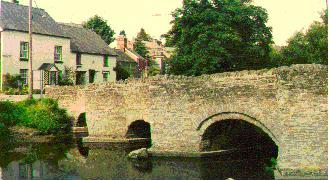
Part four of my UK (August) vacation.. This month I’ll tell you about Clun, a small part of heaven in Shropshire England. “Clungnford, Clunbury, Clunton and Clun Are the quietest places under the sun” This is how the tourist book said but the real rhyme was “the drunkest places under the sun”. I bought a post card that corrects this point (as did several locals). When I first started planning my trip to the UK, and came across the village of Clun, I knew that was where I was headed.
What attracted me to Clun? I am not sure. It could have been that it was a very small village and I much prefer villages to towns or cities. Clun had a castle, which is always a great reason to visit a place. Clun was featured in a favorite fictional series (The Roslynn Chronicles, about strong minded intelligent medieval women and the men who love them). What finalized my decision was that Clun had a very interesting sounding youth hostel - an old covered water mill. I had planned to go from Shrewsbury to Clun, but found out that the buses only go to Clun two days a week. Therefore, I went from Ludlow.
I had the pub B&B in Ludlow make breakfast early so I could catch the only bus of the day to Clun. When I arrived in Clun I knew it was going to be a great place - I had several conversations (initiated by locals) before I even arrived at the hostel. The hostel was as great as stated, though it was full with individuals from the ‘over 50’s club’ - a hiking group in which you had to be over 50 years of age to join. They made my trip more enjoyable. I met several remarkable people from Clun, including the postmaster who had a few pints with me at the pub (one of three in town), a wonderful lady who invited me to lunch at her beautiful country house (with sheep in the yard and a stream through the lawn and one of 15 internet connections in the area so I could check my email!). I also met a local archeologist who told me of the woes of his field (most excavations are done by law and are as minimal as allowed).
Clun village grew up around a church in the 7th century. At the time of the Norman conquest, the area was given to Roger de Montogomey (remember him from previous articles?). Roger gave the lands to Robert (Picot) de Say, who was the first Baron of Clun. Robert de Say built the first castle at Clun, a wooden motte and bailey that was succeeded by a substantial stone keep in the 13th century. The castle was attacked and burnt in 1194 by Prince Rhys - a Welshman. The Normans established a bourough near the castle, in a typical grid pattern. In 1204 King John granted a charter for a three day’s fair to be had at Martinmas. The lordship of Clun was forfeited to the crown in 1589 on the attainder of Philip Howard, but the lands were restored to his son by King James I in 1604. The hospital of the Holy and Undivided Trinity was founded in 1614 for ‘12 poor men with a warden, a sub-warden, an nurse and a barber’. At the time of the civil war the men of Clun became so incensed at the depredations of both sides that they banded themselves together as clubmen in order to defend themselves against all aggressors. A 14th century bridge in Clun has given rise to a local saying that ‘whoever crosses Clun bridge comes back sharper than he went’. I made sure I crossed it an ‘odd’ number of times, in case there were any negative effects of going back over it again.


Other Travels of Rowanna:
London|Shrewsbury|Ludlow|Clun|Cardiff|
|Chartres|Anjou & Angers|Cognac|Saint Emilion|Toulouse & Foix